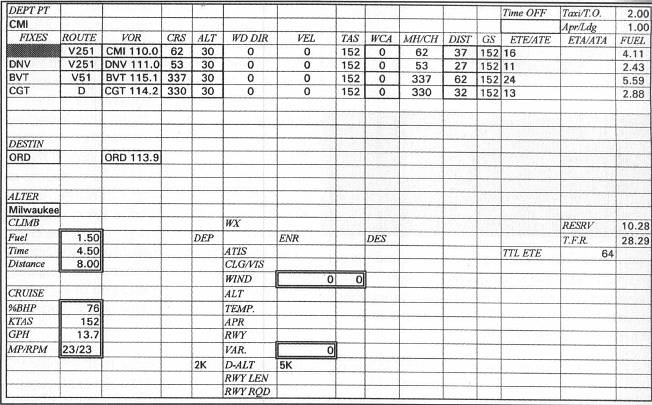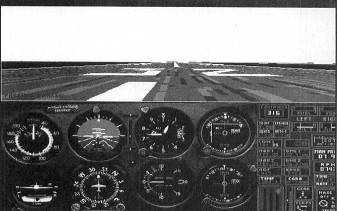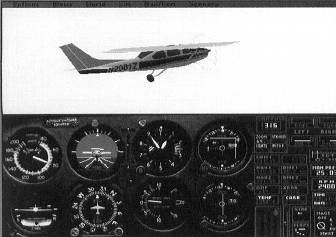Microsoft Flight Simulator Handbook
by Jonathan M. Stern
Champaign to Chicago
Use the World/Airports menu and the Chicago area scenery to place the airplane at Champaign on runway 32L. The airway structure up to O'Hare is somewhat convoluted and takes you East before you turn Northbound.
The weather for the flight is as follows:
Clouds: Bases 1,200 MSL
Tops 2,300 MSL
Coverage Overcast
Temperature: 83° Fahrenheit at 753 feet.
Barometer: 30.12—Check drift.
Winds:
Surface: 0404
Aloft:
3,000 9900
6,000 1005+16
9,000 1207+10
The flight log appears in Figure 17.17.

I have already copied the ATC clearance, which is to Chicago O'Hare Airport via V251 to BVT V51 Chicago Heights Direct. Climb and maintain 3,000. Departure frequency 121.35. Squawk 2-4-2-2. The alternate airport is Milwaukee, Wisconsin—Mitchell Field.
Set up the avionics and flight instruments for departure. Figure 17.18 shows the panel when it is readied for departure.

Take off from runway 32L and turn right to join V251. Remember from Figure 17.19 that the landing gear should be retracted only after there is insufficient runway remaining on which to make an emergency landing and the vertical speed indicator shows a positive rate of climb.

Level off at 3,000 feet and set the throttle and propeller for 23" manifold pressure and 2,300 RPMs before leaning the mixture. The wind is forecast light and variable at 3,000 feet, so no wind correction angles were planned for the flight. You may find that slight wind correction angles are nonetheless necessary. Every 10 or 15 minutes, you should check the directional gyro for drift. If the directional gyro and magnetic compass are in disagreement (they do not have the same reading) while the aircraft is flying straight and level in unaccelerated flight, the directional gyro should be reset to the heading shown on the magnetic compass. This can be done by pressing the D key or by using the mouse to turn the directional gyro's adjustment knob.
At Danville, you alter the course 10° to the left and track 27 miles to the Boiler VORTAC (BVT). At Boiler, you turn to the Northwest and track the 337° radial outbound. Because there is no changeover point along the route, you change over to Chicago Heights at the midpoint of the leg. Track Northwesterly to Chicago Heights. When you are directly over the CGT VORTAC, pause the simulation, and use the Options/Save Situation menu to save the Heights situation.
You may be wondering why you used a 3,000 foot altitude to fly both Easterly and Westerly legs. The answer is two-fold. First, in controlled airspace while flying under IFR, ATC can assign altitudes irrespective of the hemispheric rule. Second, the hemispheric rule has no application at or below 3,000 feet AGL. Exit Flight Simulator or select the Meigs Takeoff Runway 36 situation.
Table of Contents
Previous Section: Port Angeles to Everett
Next Section: Chateaudun to Paris
